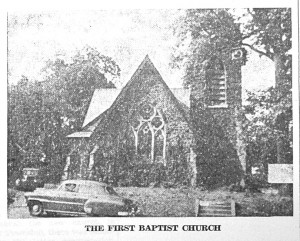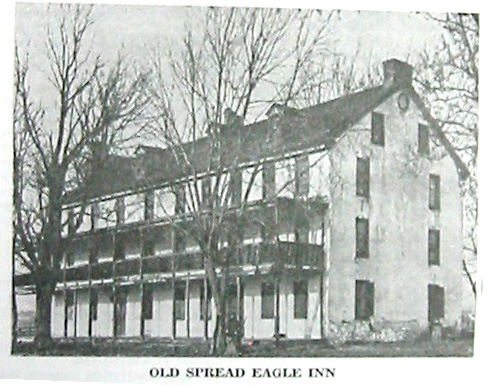The signing of the petition on February 6, 1841, by 79 members of the Great Valley Baptist Church for dismissal from that church in order that these members might form a new church of their own in the vicinity of Carr’s Corners in Radnor township, was the first formal step toward that end. Before the new congregation was really established in the small building that had once been known as Music Fund Hall, many meetings had to be held and much business had to the transacted. Some of these meetings were held in the old Carr’s Corner schoolhouse, while many others were held in the home of Brother William Siter. This was probably the old Siter homestead which once stood on the site of Herman Lengel’s present home at 250 Conestoga road.
At a meeting at which “as many of the individuals as could find it convenient assembled together to be constituted into a regular Church of Our Lord and Saviour,” a council of six men was appointed, from whom D. Bernard was named as moderator and D. A. Nichols as secretary. This council agreed that brethren present form other neighboring churches should be invited to participate in the deliberations. This resulted in representation from Great Valley Baptist Church, and from Baptist churches in Norristown, Phoenixville, Newtown, Lower Merion and Valley Forge. According to the quaint wording of the old record book of the church:
“After some questions had been asked, articles of faith and covenant were read and the Council retired for deliberations, and after consultation were unanimous in declaring that there was no proper reason why the Brethren and Sisters named in the letter should not be constituted into a regular Baptist Church. Hence they proceeded to the public recognition in the following order of exercise.”
This order of exercise consisted of singing, reading of the Scriptures, prayer, the sermon, the “Right Hand of Fellowship,” the “Constituting Prayer,” charge to the church, address to the congregation and the benediction.
Then came the matter of a minister for the new Radnor Baptist Chruch. At a meeting held on April 1, 1841, it was unanimously agreed “to give Brother Hobart a call to supply the church for a year” from that date. The license which he presented at a special meeting of the church, held in July, stated that “our beloved brother Isaac M. Hobart . . . is a regular member of the Calvinistic Baptist Church of Christ in Lyme, in good repute with us as a young man of piety, correct morals and promising gifts; and he has been regularly approbated by us as a licentiate preacher, sound in the faith of the gospel.”
Brethren George Phillips, Zimmerman Supplee and William Siter were appointed at the April meeting to inform Brother Hobart of the call and “to confer with hi on terms.” The three reported back at a somewhat later date that these terms would be “three hundred dollars and expenses to and from the city.” Although the congregation voted unanimously to accept Brother Hobart, they added that when the committee of deacons waited on him they were “to prevail on him if it could be, to lower the terms.” Brother Hobart must have proven most acceptable to his congregation, for by the following year he had the temerity to ask for a salary of $400!
Brother Adam Siter was elected sexton of the church, “with the understanding that a collection would be taken up for him every quarter.” A later note in the record book shows that the first collection amounted to $7.57. Brother George W. Lewis was appointed church clerk and he was “directed to procure a blank book in which to record the proceedings of the church.” This is undoubtedly the book which is now before your columnist as she writes. Its pages are frail with 100 years of existence, their one-time white surface brown and stained, their edges soft and crumbling, yet the record of those early days of the church, written in a fine, regular hand, are almost as legible as when they were penned by Mr. Lewis.
Other business to come before the spring meetings were the appointment of a building committee “for altering the house,” to consider the building of a school house, and to acquire ground for horse sheds and a graveyard. The board of trustees reported that they had obtained this additional portion of ground from brother William Siter at the approximate price of $760 which, in addition to the original price of $700 for Music Fund Hall, brought the total purchase price to $1,460. However, “the additional purchase bro. Siter was willing to relinquish for the sum of one dollar, which added to 700 dols. the sum to be paid for the first purchase, amounted to $701.” However, bills for repairs on Music Fund Hall amounted to $245.43, and as the total amount for subscriptions from church members amounted to only $383 to date, “the debt against the church” was $563.43.
Other urgent matters in the first months of the new church’s existence, in addition to financial ones, were the decision in regard to the form of the charter to be forwarded to the State Legislature, “praying for an act of incorporation” and steps to be taken in regard “to offering themselves for union with the Central Union Association.” Eventually, both charter and membership in the association were obtained. Another matter of business was to have the church insured in the Mutual Insurance Company of Chester County.
In September, 1842, the Radnor Baptist Church was in difficulties with the parent church when they accepted as members “in good standing and full fellowship” four former members of the Great Valley Baptist Church was were “under censure for specific improprieties,” according to a letter received form the other church. This was done “before the cause thereof was removed.” This the Great Valley Baptist Church considered “in violation of the usages of the denomination, contrary to the spirit of the gospel of Christ, which requires that ‘all things shall be done decently and in order’.”
In reply, the Radnor church stated that the four members in question had come to them “as members of no church, and as such we received them in the relation of their Christian experience,” adding that “we still regard your body as our mother church and regret exceedingly that she has thought proper to disinherit us.”
(To Be Continued)


